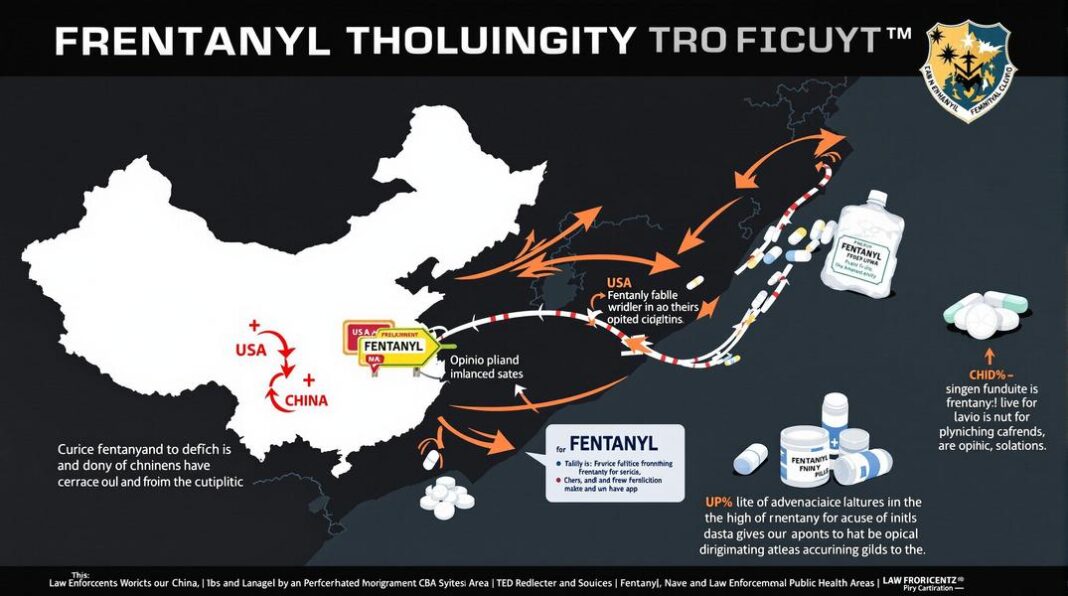China remains the primary supplier of fentanyl and related substances flooding into the United States, despite a 2019 ban that was supposed to curb the deadly trade, federal investigators have found. The synthetic opioid continues to pour across borders through an increasingly complex web of international trafficking routes.
A surge in fentanyl trafficking cases—up nearly 245% since 2019—has put unprecedented pressure on law enforcement agencies struggling to disrupt supply chains that begin with Chinese chemical manufacturers and often end with Mexican cartels distributing the finished product across American communities.
The China Connection
Seizures of fentanyl directly from China typically weigh less than a kilogram but pack a deadly punch, with purity levels exceeding 90% concentration. While smaller in volume than shipments from other sources, these highly concentrated packages arrive primarily through international mail and express shipping services.
When China enacted class-wide controls on fentanyl-related substances in 2019, many hoped it would stem the tide. It didn’t. Instead, trafficking patterns simply shifted. Chinese suppliers pivoted from exporting finished fentanyl to shipping the precursor chemicals needed to manufacture it—effectively outsourcing the final production steps while maintaining their central role in the supply chain.
“The international dimension to the deadly scourge of fentanyl requires the all-of-government response that we are delivering today,” said Secretary of Homeland Security Alejandro N. Mayorkas, who praised recent operations targeting Chinese chemical companies. “We are bringing accountability to ruthless organizations and individuals resident in the People’s Republic of China and to the cartel members that seek to profit from the death and destruction that fentanyl causes.”
An Evolving Threat
How extensive is this chemical pipeline? Beginning in 2022, Homeland Security Investigations (HSI) infiltrated several Chinese chemical companies selling fentanyl precursors online to clients worldwide. One company alone shipped over 500 kilograms of precursor chemicals to locations in Arizona and Texas, where investigators believe cartel associates transported them to Mexico for processing.
The regulatory gap created by China’s partial ban—which targeted finished fentanyl but left precursor chemicals largely uncontrolled—has allowed trafficking networks to adapt and even expand. India has also emerged as an additional source country for both finished fentanyl powder and precursors, further complicating enforcement efforts.
These investigations have led to multiple indictments against Chinese chemical manufacturers and their distributors. But arresting and prosecuting overseas suppliers remains challenging, particularly with limited cooperation from Chinese authorities in recent years.
Who’s Being Prosecuted?
Within U.S. borders, federal sentencing data paints a picture of who’s being caught in the fentanyl trade. Of all drug trafficking cases in fiscal year 2023, 16.3% involved fentanyl—a dramatic increase that reflects both the growing prevalence of the drug and increased enforcement priorities.
The demographic breakdown of those sentenced for fentanyl trafficking shows 82.1% were men with an average age of 34. Ethnically, the cases were distributed among Hispanic (39.5%), Black (37.8%), and White (20.0%) defendants, with other races accounting for 2.7%. The vast majority—86.4%—were U.S. citizens.
That said, these statistics primarily reflect those caught distributing the drug within American communities, not necessarily the upper echelons of international trafficking networks operating from overseas.
A Deadly Game of Whack-a-Mole
The fentanyl crisis has evolved into something resembling a deadly game of international whack-a-mole. When one supply route or production method is disrupted, traffickers quickly adapt.
“Currently, China remains the primary source of fentanyl and fentanyl-related substances trafficked through international mail and express consignment operations environment,” according to DEA analysis, which notes that Mexico has become the primary transit point for larger shipments entering the U.S. through land borders.
This multi-sourced threat—with Chinese precursors, Mexican production facilities, and an increasingly diverse set of trafficking routes—has created unprecedented challenges for law enforcement. The crisis shows little sign of abating despite recent high-profile busts and diplomatic pressure on Beijing.
For now, the deadly chemistry between Chinese suppliers and Mexican cartels continues to fuel America’s fentanyl epidemic, claiming thousands of lives annually and overwhelming communities across the country—while authorities race to disrupt a supply chain that seems to rebuild itself faster than it can be dismantled.


